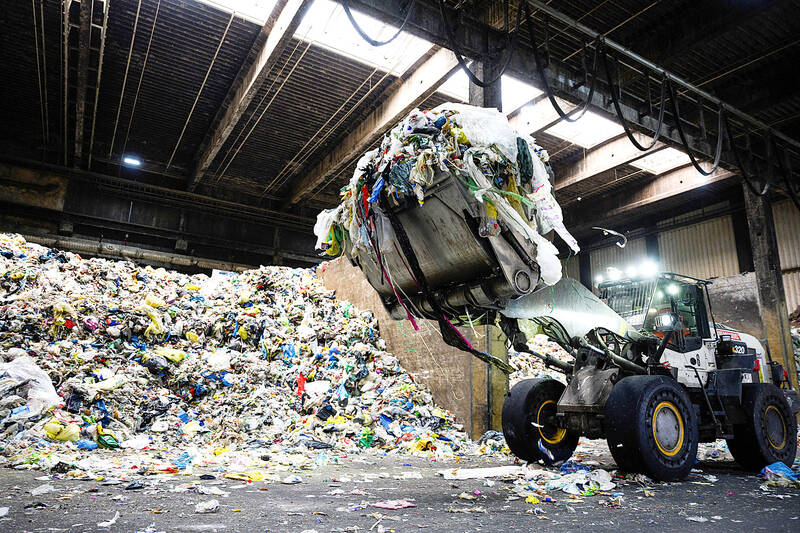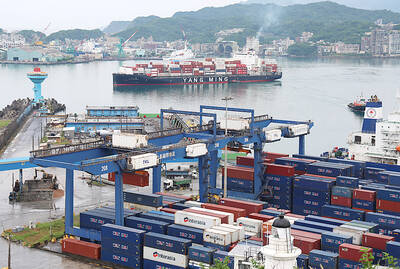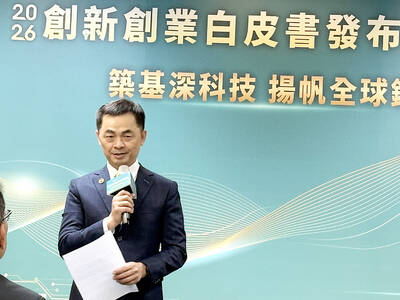Talks aimed at a global treaty to cut plastic pollution fizzled in Geneva this week, with no agreement to meaningfully reduce the harms to human health and the environment that come with the millions of tons of plastic water bottles, food containers and packaging produced today.
Although as many as 100 countries sought caps on production, powerful oil-producing nations like Saudi Arabia and the US stood against them. They argued the caps were unnecessary and a threat to their economies and industries.
That means any progress continues to depend on efforts to improve recycling, reuse and product design — the very things that powerful nations argued were sufficient to address the problem without resorting to production cuts.

Photo: REUTERS
The world makes more than 400 million tonnes of new plastic each year, and the Organisation for Economic Co-operation and Development (OECD) estimates that could increase by about 70 percent by 2040 without meaningful change. A great deal of that ends up in landfills or, worse, the environment.
Pollution is not the only problem. Plastics, made almost entirely from fossil fuels, are a major contributor to greenhouse gas emissions. Plastics generated 3.4 percent — or 1.8 billion tonnes — of planet-warming emissions across the globe in 2019, the UN said.
So, how effective has recycling been so far?
Not very.
It is notoriously difficult to recycle plastics; only 6 percent of what is made gets recycled, according to the OECD. That is largely because different kinds of plastic cannot be recycled together. They have different chemical compositions, making it costly and time-consuming, and requiring a lot of manual sorting.
“There are many different colors of plastics, many different types of plastics called polymers, and 16,000 to 17,000 different chemicals used to make plastics, so by design, plastics are not easily recyclable,” said Judith Enck, president of Beyond Plastics, an organization that works to cut plastic pollution.
Experts say plastic is different from materials like paper, cardboard, metal and glass, which all get reused at much higher rates. The US Environmental Protection Agency estimates glass recycling at about 31 percent, and things like steel cans at about 71 percent. As much as 64 percent of paper and 74 percent of cardboard get recycled, according to the American Forest & Paper Association.
However, “if you just think of your own home or apartment, you might have a bright orange hard plastic detergent container on top of your washing machine, and then you might have a plastic bag,” Enck said. “Those two things cannot get recycled together.”
The plastics industry says innovations in material science are helping to incorporate more recycled plastics into products and enable more plastic products to be recyclable. Ross Eisenberg, president of America’s Plastic Makers, noted the need for an “all-of-the-above approach.”
This also includes upgrading recycling infrastructure or improving sorting to capture more used plastics, he said, adding that it also means making recycling more accessible, and helping consumers know what can and cannot go in the recycling bin.
However, there are a lot of limitations to this.
Depending on consumers for accurate presorting is a lot to ask. Cities might hesitate to make costly infrastructure improvements to their recycling programs if there is little financial incentive or market for the recycled material.
“Local recycling facilities, or markets for the recycled material, don’t always exist. Where the collection and processing infrastructure does exist, the recycling plants are essentially plastic production facilities, with the same air, water, and soil pollution problems that are harmful to local residents,” said Holly Kaufman, director of The Plastics & Climate Project and senior fellow at World Resources Institute.
Further, mechanical recycling mixes used plastic with new plastic, and the addition of more chemicals. It also requires other steps that shed much smaller plastic particles into the environment.
Plastics recycling also usually requires plastic that has never been recycled before — called virgin plastic — as used plastic is weak, Kaufman said. “It does not make much of a dent.”
California is currently suing oil and gas giant Exxon Mobil, alleging deception about the possibilities of plastic recycling.
Because of this, Kaufman said, “the aim should be to significantly reduce plastic production, use, and waste, not recycle more.”
“Reuse means creating packaging or products designed to be used multiple times, like refillable containers, or more durable zippered bags that can be washed and refilled many times, extending their lifespan and reducing waste,” said Eisenberg, of America’s Plastic Makers.
Experts say reuse is extremely important, but reusable products should not necessarily be used for consumables because of the risk of microplastics.
Redesigning plastic often means making it easier to recycle. That can be using one material in packaging instead of several, or printing labels directly onto a container rather than using a separate one that is glued on, but that is more complex.
Alternatives to plastics could also be made out of sustainable, less harmful and even regenerative materials, such as seaweed, Kaufman said. There has been progress on this front, but most solutions have not scaled up yet.

CHIP RACE: Three years of overbroad export controls drove foreign competitors to pursue their own AI chips, and ‘cost US taxpayers billions of dollars,’ Nvidia said China has figured out the US strategy for allowing it to buy Nvidia Corp’s H200s and is rejecting the artificial intelligence (AI) chip in favor of domestically developed semiconductors, White House AI adviser David Sacks said, citing news reports. US President Donald Trump on Monday said that he would allow shipments of Nvidia’s H200 chips to China, part of an administration effort backed by Sacks to challenge Chinese tech champions such as Huawei Technologies Co (華為) by bringing US competition to their home market. On Friday, Sacks signaled that he was uncertain about whether that approach would work. “They’re rejecting our chips,” Sacks

Taiwan’s exports soared 56 percent year-on-year to an all-time high of US$64.05 billion last month, propelled by surging global demand for artificial intelligence (AI), high-performance computing and cloud service infrastructure, the Ministry of Finance said yesterday. Department of Statistics Director-General Beatrice Tsai (蔡美娜) called the figure an unexpected upside surprise, citing a wave of technology orders from overseas customers alongside the usual year-end shopping season for technology products. Growth is likely to remain strong this month, she said, projecting a 40 percent to 45 percent expansion on an annual basis. The outperformance could prompt the Directorate-General of Budget, Accounting and

NATIONAL SECURITY: Intel’s testing of ACM tools despite US government control ‘highlights egregious gaps in US technology protection policies,’ a former official said Chipmaker Intel Corp has tested chipmaking tools this year from a toolmaker with deep roots in China and two overseas units that were targeted by US sanctions, according to two sources with direct knowledge of the matter. Intel, which fended off calls for its CEO’s resignation from US President Donald Trump in August over his alleged ties to China, got the tools from ACM Research Inc, a Fremont, California-based producer of chipmaking equipment. Two of ACM’s units, based in Shanghai and South Korea, were among a number of firms barred last year from receiving US technology over claims they have

BARRIERS: Gudeng’s chairman said it was unlikely that the US could replicate Taiwan’s science parks in Arizona, given its strict immigration policies and cultural differences Gudeng Precision Industrial Co (家登), which supplies wafer pods to the world’s major semiconductor firms, yesterday said it is in no rush to set up production in the US due to high costs. The company supplies its customers through a warehouse in Arizona jointly operated by TSS Holdings Ltd (德鑫控股), a joint holding of Gudeng and 17 Taiwanese firms in the semiconductor supply chain, including specialty plastic compounds producer Nytex Composites Co (耐特) and automated material handling system supplier Symtek Automation Asia Co (迅得). While the company has long been exploring the feasibility of setting up production in the US to address